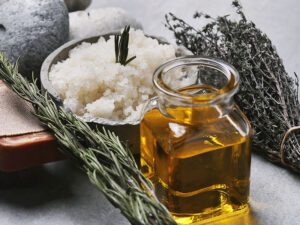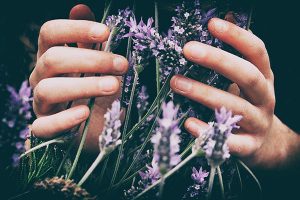How to Do Effleurage Massage Strokes
Effleurage are the gentlest style of all strokes used in Swedish, Deep Tissue and in parts of Indian Head treatments. There are 3 different types of effleurage. The long stoke is used over large areas all over the body, circling can be used on the torso and feathering is used all over the body as well.
What is Effleurage?
Cambridge dictionary tell us the word effleurage is derived from the French verb effleurer which means to touch gently. This is an apt description of these gentlest of massage strokes. The different types of effleurage include the long stoke, circling and feathering. These are all superficial strokes during which palpitation (feeling for tension with your fingers) should take place. The full hand surface is used including fingers, thumbs and palms in all but feathering. Tucker L (2016) says the pressure used varies. Light pressure is used at the start and end of a treatment. Medium and heaver pressures may be used in-between. Its aims are to warm up, sooth and relax tissues, as well as covering the skin in oil.
Types of Effleurage and Its Effects
I will now look at the 3 definite types of effleurage stoke individually and explain how to do them, where they can be used and what some of the effects of them are.
1) The Long Stoke
- The Long Stroke is used on large areas like the back.
- It is first used to cover the area in oil (or other massage medium).
- Mo Rosser (2016) tells us to take a standing stance next to our client with front foot pointing forward in a T stance. As you need to move up and down your client, shuffle with your front foot going first, bringing your back foot along afterwards. This will allow you to remain upright with your arms at the same oblique angle all the way through the stoke.
- Cover your hands in oil and warm it up by rubbing together.
- Introduce hands gently at the base of the spine, 1 hand either side of it. Move up in the direction of venous blood flow.
- A gentle increase in pressure should take place using your body weight, not your muscles. Maximum pressure should be as you end the stroke close to some lymph nodes. On the back these would be the axillary lymph nodes and subscapular lymph nodes in and around the armpit.
- Effects of Long Strokes: Initial preparation of the body for massage. Covers the skin in oil ready for further, deeper strokes. Increase in venous blood flow and lymph flow.
2) Circling Effleurage
- Circling is used to warm up and sooth the skin and underlying tissues.
- It can be done from the side on the torso. In this circumstance you will have to walk around the other side of your client to repeat.
- Your stance this time should be both feet pointing under your client and the table. You should bend at the knees, to make sure your are at the right height for the pressure you are using.
- Hands are placed separately, 1 on the hip (gluteus maximus) and the other on the mid-ribcage (lastimus dorsi).
- Hands move in circles, in opposite directions. 1 clockwise and 1 anticlockwise. Hands should never meet. So as 1 is coming up the gluteus maximus the other should be coming down the lastimus dorsi and vice versa in the other direction of rotation. You can choose to change the direction of rotation at any point, as long as you do so with both hands at the same time.
- Your upper torso should move rhythmically left and right, as if you were gently, slowly dancing.
- You can vary the pace to be more vigorous but, should slow back down again as you finish.
- Effects of Circling: As with the long stoke. Also, the increase in blood flow to the surface may give reddening of the skin.
3) Feathering Effleurage Stroke
- Feathering is used to tell clients a body area is about to be completed and you are moving to another area or you are finishing the treatment completely.
- Only fingers are used, not the entire hand.
- Let’s start by moving from 1 body part to another (1 arm to the other). Once and arm is completed, place the blanket back on to cover. Gently place the finger of 1 hand on the blanket and move yourself from one side of the client to the other.
- Your hand should never leave the client. Simply stay in touch and gently feather as you move.
- A better example of this stroke is when you choose to finish your massage on your clients back.
- Once you have completed the upper and lower back, place 1 hand gently at the top of the spine in its centre. Slowly move this hand down the spine using less pressure as you go down.
- When 1 hand has reached the middle of the spine (1/2 way between neck and buttocks), place the other hand in the same starting position at the top of the spine.
- When the first hand has competed its journey to the base of the spine, gently remove it and start the sequence again.
- Repeat with both hand 3 to 5 times going slower with each rendition.
- Effects of Feathering: This is the gentlest of all types of effleurage. It is by the end of the massage almost unnoticed. It tells your client that the massage is still in progress. It gives your client an idea of where you are going to be working next. At the end of a massage, the gentlest of touches is sued and you client will understand once your hand has left their body, their massage has finished.
References:
Cambridge dictionary (No Date) Translation of “effleurer” – French-English dictionary [Online] Available from https://dictionary.cambridge.org/dictionary/french-english/effleurer Accessed 18/09/2018
Rosser, M. (2016) Body Massage Therapy Basics, London, Hodder & Stoughton
Wikipedia (2018) Subscapular axillary lymph nodes [Online] Available from https://en.wikipedia.org/wiki/Subscapular_axillary_lymph_nodes Accessed 18/09/2018
Tucker, L. (2016) An Introductory Guide to Massage, London, EMS Publishing



















